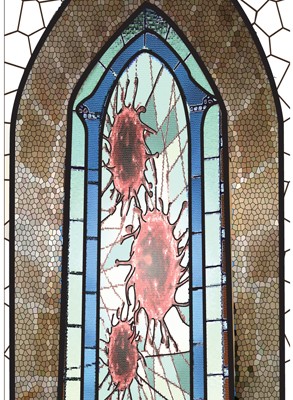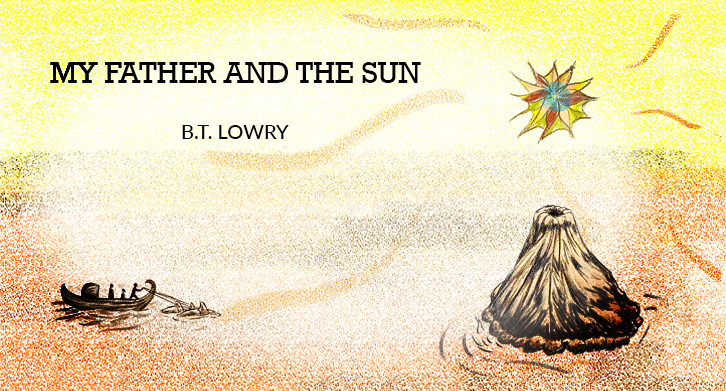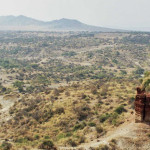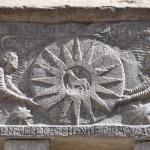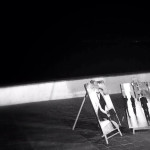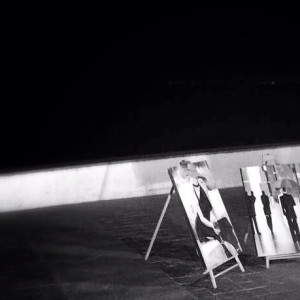If you visit the planet Azagarth, bring warm clothes. Most of the year it’s under five degrees Celsius, and even colder in the valleys, around which the ice — which is orange here, not white, due to some strange refraction of the dual, distant suns — rises like the mouth of a volcano. But this is where the hikhik, the indigenous tribes of Azargarth, choose to live. Their stout, square homes sit within the great circles of ice in a way that reminds me of the ancient walled cities of Europe’s middle ages.
“It’s not a welcoming planet,” says Sister Therese, when I arrive at the mission. “You don’t see the resort companies queuing up for space. No one wants to come here. Too flat for the skiing crowd, and summer’s too short to melt the ice. We get tourists, sometimes, and other missionaries… and journalists, of course.”
Her tone slips from friendly to testy, and I realise she’s still suspicious of me. As she has every right to be, given the situation. Journalists are far from uncommon on Azagarth. Tourists may not like the weather or the scenery, but journalists — especially photojournalists — love the hikhik, a race of plasmoid mimics. There’s been a recent fancy for earth’s tabloids to print pictures of hikhiks masquerading as celebrities, with one particular attribute grossly exaggerated — a chubby Pinky Bryant with breasts like torpedoes, a Jim Vagner with oversized lips that dangle to his collarbones.
I am not a photojournalist, I explain to Sister Therese, but a staff writer for HeLives magazine, a monthly Christian digest with a solid publishing record (40 years with Christ, as it says on the cover). “I’m here to tell your story,” I reassure her. “This is an amazing moment in history, not only for the church but for the entire human race — our first dealings with an alien race significantly less advanced than our own.”
She smiles in a faint, restrained way and shows me to my room, a small cell — although, despite its name, it is quite a cosy place. I have a bed, a desk, and a shelf on which to stick my clothes. My window, which is wide and covers almost the entire eastern wall, looks down upon the hikhik settlement. I can’t see them as the light outside is too dim, but I can hear them chattering to each other in their slow, monotonous voices. Speech and language itself is new to the hikhik — the first gifts of the human missionaries. They have been taught English, Sister Therese tells me, and some Latin, so as to better understand the Catholic Mass.
When the sister leaves me I begin a rough draft of my article’s outline (a misguided, optimistic early version of the article you now read). I check my notes on the mission’s history — eighteen months now in hikhik country — and the history of the planet itself. First discovered twenty years ago, Azagarth has been settled and resettled numerous times, but no one has ever stayed. The Christian missions, known here collectively as the St. Christopher’s movement, are the longest settlement of humans on the planet.
As I turn in for the night I notice something strange about my room. Two glowing red heater-beams hang ominously above the bed; on the wall directly opposite is a simple crucifix. There is something childishly terrible about this: I am to sleep between my God and a warm place.
* * *
I meet the hikhik the next day. A younger sister, who insists I call her plain Paul instead of Sister Paul, leads me from the mission building to the school. The school is a rough, square building, clearly built by the hikhik themselves, and one side leans heavily against the mission’s solid, human-made wall. It is about as big as a tennis court, and painted with surprisingly realistic murals of Biblical scenes.
“The hikhik reproduced them perfectly from the movies and books we gave them,” says Paul. “They’re amazingly talented.”
Inside the school, a lesson is in progress. Half the room is filled with simple plastic desks, while the rest of the class — the younger children, I assume — sit on the floor at the teacher’s feet. The teacher is an elderly nun with fine dark features and an animated way of moving her hands. She is teaching them about the story of Noah, from what I can tell. Her image and voice are projected as a hologram at the room’s midpoint, so every student is able to hear and see her. I expect that sort of tricky software was financed by one of the St. Christopher movement’s rich backers — Sister Therese has been guarded when I ask her questions about money, but I’ve done enough research to know that there are a lot of people back home determined that this mission proves a success.
But, of course, it isn’t the nun or the holograph I really notice first, but the hikhiks themselves.
There are perhaps a hundred and fifty of them squashed into the room. Most of them have taken on semihuman forms, replicas, I assume, of past tourists and travellers to Azagarth. Others are 2D cartoon characters and trees and icicles and countless other things that they’ve mimicked since their first interactions with humans. An empty argyle-patterned coat scribbles industriously on its pad; a Siamese cat raises its hand to answer a question; a computer takes down the lesson by pressing its own keys. The letter E — the actual letter — is sitting on my far right, its lowest branch tucked under the desk, the middle one clutching a pencil, while the topmost looks toward the teacher, a flat face straining on a hideously long neck.
“It’s okay if you want to take a minute,” says Paul. “People usually do when they see them. I expect if you’re not used to it, this can all seem a little strange.”
“It’s like a Mary Poppins fantasy,” I say — too loudly, because instantly the two hikhiks sitting nearby have turned into perfect simulacra of Dick Van Dyke. One of them begins to rise toward the ceiling, his mouth opening and closing in silent laughter.
“Oh, you’ve distracted them,” says Paul, sighing, and ushers me out.
As I go I see something I wish I hadn’t; one of the hikhik has assumed the form of — terribly — a tortured Jesus on the cross. It’s just a brief flash, before it syncs its amorphous body into some other weird mutation, but it’s definitely Jesus. The sight fills me with horror, but when I tell Paul about it, she smiles and shakes her head.
“They’re funny things, aren’t they? They don’t really know what they’re doing. Obviously when we catch them at it we tell them off, but I don’t think they all understand blasphemy yet. You can’t really be annoyed at them; it’d be like getting cross at a small child.”
My next visit today is to a young family who are proud members of the St. Christopher movement. At the door I am warmly received by the lady of the house, who after clasping my hand and performing a small hikhik ceremony of whistles and smiles, leads me to the kitchen, where her husband is cooking a meal for their four children.
“Meat vegetable meat horse,” the husband says, also smiling, his green teeth sparkling. “Bowl soup fork vegetable fork.”
“On earth as it is in heaven,” says the wife, somewhat apropos.
We eat the food — which is good, delicious even — and make stilted conversation. The hikhik can’t talk, not really; they suffer a strange echolia that allows them to repeat back anything they’ve ever heard, and when they don’t have an appropriate answer in their phrase-bank, they subside into nonsense. For example, when I ask them how many children they have, they say, “four,” and when I ask them their jobs and they chant, delightedly, “A farmer wants a wife, a farmer wants a wife,” but when I bring up the missions, and what they think about them — a question that requires a personal opinion — the wife can only manage a few stilted passages from Genesis before giving up. Her husband doesn’t even try.
I remember reading stories about feral children, brought back from the wild, who grew up to understand words but not language. They were literalists of the purist sense — they saw only the nouns and verbs of this world. The hikhiks’ whole-hearted embrace of Christianity confuses me, because Christianity is not a literal religion — its books are contradictory, its timelines and lineages conflicting, and its passages have been interpreted and reinterpreted to mean different things at different points in history. Is it a wise idea to give a book such as the Bible to a people who are unable to differentiate between spiritual guidance and spiritual dictate?
“Well, you know what happened in Kenya back in the ‘zeros,” says Paul later, when I breach the subject. “We taught them about God and Jesus and then a few years later, we came back to find they were burning people as witches and casting the devils out of small children for exorbitant fees.”
“How do you know that won’t happen here?”
“Don’t tell anyone I told you this, but humans at heart are wicked things. Sometimes I think they’re out looking to find temptations. While the hikhik, they’re true innocents. True children of God. They could never do anything terrible or wish ill upon another.”
“They like to please people,” I say. “They like to please the missions.”
Paul nods. “They want to know God. We can show them the way.”
* * *
A moment of truth: I am a Christian of the forever-lapsing sort. I fight my faith and my faith fights back and my infrequent truces with God are as uneasy and uncertain as my convictions. It is my own fault I am this way; I did not go peaceably into the bright light of salvation. In school I chose to study biology, which was, in its substance, silently disproving of God; in college I took an elective course in abiogenesis, which was worse. I had hoped learning about science would strengthen my faith, but instead I felt it slipping, as if I were emerging from a cocoon and would soon be exposed, painfully, to the terrible darkness of a Godless life.
And yet somehow my belief, although damaged, did not die. In desperation I read the works of the apologetics, and was reassured. Now I think of my religion as one would a job — I work at it, it exhausts and perplexes me, but it is occasionally rewarding. At this point in my life, occasional rewards are enough to satisfy me. Perhaps in the future this will change, but I doubt it. I am a simple-living man.
The editors of HeLives won’t like me saying this, but the idea of bringing a new religion to a non-human country disturbs me on some level. I won’t be the first to point out that the Bible never mentions aliens — really, do they even have souls? And did Jesus, who died for all mankind, die for their sins too? I have always thought of Christianity (and, I suppose, other religions too) as an evidence of our humanity. No other alien race has a religion, at least as we understand it, although a few revere their ancestors in a similar way to some Asian and Pacific Island cultures. Mission work with aliens, especially the more advanced cultures, has been embarrassingly fruitless. Only the hikhik have shown any sign of interest in faith — any faith — and I’m starting to think that the St. Christopher movement may have mistaken a genuine desire to know God for the hikhiks’ innate ability to show people what they ask for.
On my third day on Azagarth I am left to my own devices; Paul, who was a triage nurse before getting the call, has been called away to attend to a sick priest. I take the time to walk around the settlement, which is perhaps three kilometres wide. I am the only human on the gravelled streets, and on spotting me the hikhik children come whooping down from doorsteps and swings and chase after me in a myriad of different forms. In a group they seem to have a fondness for copying each other — it is a sort of game amongst them, I think. At one point I am being followed by a veritable forest of limber-rooted eucalypts; at another I lead a pack of furiously waddling daschunds.
After a time I get used to them, and ignore them — believe it or not, there is only so much hikhik weirdness that a person can take before they tune it out. Instead of watching the children, my mind drifts to thoughts of home and of the church my wife and I attend. We are members of a tiny Unitarian congregation — the Unitarians forgive my struggles with faith more than the Baptist church we left some years ago (there, they always considered me a backslider, and a seemingly unrepentant one at that). Our pastor is an older man who gets on well with my wife, who is often as inquisitive of her faith as I am. I expect that while I am away she will be spending most of her time in his company; and it is with these things in mind that I turn around to check, absently, on the activities of the children behind me.
They are doing an awful thing.
I am sorry to write this; trust me when I say that I do not want to write this, that the very idea of putting it down on paper upsets me. But I am a journalist — I have always believed (perhaps blasphemously) that journalism, too, is a calling to truth — and I must chronicle without judgement and without bias. So here it is: the children have assumed the naked forms of my wife and my priest, and they are fornicating.
I think I must have screamed or shouted because instantly the children, seeing my distress, turn into other things — into pretty, silly, inconsequential things, like teddy bears and fruit and balloons and books. It’s so fast, so harmless, like a kid pulling a face behind a teacher’s back. Except that what they’ve shown me is not harmless, and it shakes me to my root. I am not easily enraged — and, please understand, I have never before yelled at a child — and yet I rush at them, at their balloons and toys, bowling them over and sending them yelping and scattering back to their homes. Some hikhik adults exit their homes to stare at me, this shaking, sweating, shamed human in their midst.
“There but for the grace of God,” says one, and vanishes back into his house.
As I walk back to the mission building I see Mary Magdalene cuddling a boil-encrusted Job in a thin alley between two streets. Three lepers, one with no arms, are licking their feet with forked tongues. I know who they are, because I’ve seen the movies; they are appearing in the same guises as actors in a recent series of Bible movies produced by Word, a Christian company that also owns HeLives magazine. Needless to say, this debauched scene does not appear in any of Word’s productions.
“They can read minds, sometimes. Or read feelings,” says Paul later, scrunching up her face. I’ve told her something happened in the village, but not the precise details. Still, she seems to have guessed some of it, if not the particulars. “I’m not sure how it works, but if you’re thinking of something, they can replicate it.”
“I wasn’t thinking about that.”
“They just get the images, the shapes. They put them together in whatever way they feel is right. I know, I know, they’re difficult and alien but at base they have good hearts. I’m sure they didn’t mean to offend you. In fact, they were probably trying to impress you.”
I wish I had words to explain what I fear about the hikhik. At base I suppose it is that they are not human — which sounds bad, in this multi-species world, where aliens are our friends, our co-workers. So perhaps I should say that they are inhuman, they do not possess any of the traits our intergalactic colleagues do: they do not understand empathy, or speech, or opinions, or that doing what they did went beyond a simple childish prank into something truly twisted, wicked, and perhaps, evil.
There’s an article I did for HeLives last winter about a mission in Sudan. I wrote dispassionately and faithfully about the deaths of starving children and adults; my friend the photographer Joe Halliewell took pictures of bodies ravaged by poverty, people reduced to little more than walking skeletons. It upset me, but it did not unhinge me. There was an evil in Sudan, but it was a natural, human evil; it was containable and understandable. The evil of the hikhiks is a truly alien thing, it is an evil of miscommunication and, in fact, a complete lack of communication. It chills me because I know, with a strange certainty that I’ve never felt about any other alien race, that these are truly soulless things.
“Pray with me,” says Paul, taking my hand. “Please?”
We pray together in the mission’s chapel. There are no hikhiks here, and it makes me feel better — until I realise that there may in fact be hikhiks in the building, hundreds of them, and I will never be able to distinguish them from the humans, or other inanimate objects, unless they change shape in front of my eyes.
* * *
On day four (I have only five to spend in Azagarth, before HeLives propels me on to the Hi’iknthis cluster and a story on a congregation of earth migrants) I leave Paul behind and seek out a hikhik interviewee. I do not want to, and I would far prefer to sit in my cell until my shuttle leaves the following night, but I have an article — this article — to write.
I walk out amongst the hikhiks. Once I am well away from the mission, they start to taunt me. There are more images of my wife, and more images of things I choose, as a Christian, writing for a Christian audience, not to describe. There are Biblical scenes, perverted beyond recognition, in which the wise men eviscerate a limpid-eyed Mary, the shepherds have the heads of their sheep, and the holy child rides a three-headed goat. There are nuns, nuns I recognise (the stony faced Sister Therese is amongst them) in various states of undress. And yet at the same time there are other banal images, there are playful monkeys and bunches of flowers and smiling clouds and a lamppost that gleams with a real and near-phosphorescent green light.
Have the nuns never seen them do this? I wonder. Is this a performance for me alone? Or — and this is the worst possibility, the one I hate to consider — are the nuns so pure that such things would never enter their minds? I cannot see any connection between my thoughts and the most horrible of the images, and yet some of them — I won’t say which ones — seem strangely familiar, as if they have been plucked from a distant nightmare. Have the hikhik plumbed the depths of my subconscious for material?
“What are you?” I ask them. “Why are you doing this?”
“Hikhik,” offers a toy train that moves awkwardly along a wooden track.
“We are legion,” says another, ominously, but it’s only reciting words it has heard before in the mission’s classrooms.
“Why are you doing this? Why are you doing this? Why are you doing this?” a child chants, caught in an echoliac loop like a Tourettes sufferer.
“Please,” I say, gesturing to the twisted nativity. I am slowly, impossibly, regaining my self-control. “Stop this. It’s blasphemous. It’s horrible. Surely the nuns have told you that.”
“God loved the world so much he gave us his only son,” says the three headed goat in an agreeable tone, and reverts into the shape of a single, flailing bulrush. Others repeat the famous passage after it; the words tumble through the nativity’s members like a virus, spreading, until they are all bulrushes and my wife has become the brown path of the Nile through a muddy delta made of refashioned nuns. A single hikhik, as a basket, floats along their backs, but never reaches the shore.
“Do you even understand what religion is?” I ask. “Do you understand Christ’s message? Yes, I know, you can paint pictures of Bible scenes, you can even become them, but there’s no point unless you understand their meaning. The nuns here are very wonderful, and it would hurt them to know they had wasted their time with you all. If you can’t feel, if you can’t grasp what it means to be saved, then there’s no point in them continuing with the mission.”
“We like nuns,” says the basket. Around it the Nile peels back and becomes the Red Sea; the basket swells and becomes an ark; the Red Sea converges into flood waters. “We like nuns,” it says again. “They show us. What we can be.”
I cover my face with my hands. “They aren’t here to show you new shapes to form. They’re here with a genuine desire to help you find God through his son, Jesus Christ. They’re here to help you form a spiritual relationship with our Lord. This isn’t a game to them. And if it’s a game to you, you need to stop. It’s unfair, it’s horrible.”
At the word horrible images of my wife and my priest reoccur. I see flashes of flesh between my shaking fingers. It is cold out here, freezing, but my anger, my frustration, keeps me warm. “Stop it,” I say again. “What you’re doing is not appropriate; it is rude and offensive. Do you understand?”
The ark reappears. Animals approach it, two-by-two. I recognise this scene from a Word documentary on the flood; the animals have a false, computer-generated quality about them.
“Christ suffered,” I tell them. In all my years I have never had this conversation; I have never had to explain my faith to another, although many have helped confirm mine. “Christ, the son of God, died for your sins. It is the greatest act of kindness and sacrifice the world has known. And even if you do not believe in what he did, at least show some empathy and respect. What you are doing here, with your images, with your perversions, is denigrating our faith.”
“Sorry,” says a giraffe. Its mouth is pulled down dramatically at the corners. “We are sorry.”
“Forgive us,” says a hippo. “We seek forgiveness.”
“We will be Christ-like,” promises its mate. “We will be as little children.”
“Please,” I say. It’s hard to tell if I’ve gotten through to them — their faces, no matter their form, are always completely impassive and mask-like. I wonder if this is because they are hiding their feelings, or if they have no real feelings at all. The devil, I remember my priest once saying, has only the face men make for him. “For the sake of the mission. A lot of people are counting on you to be our first shining example of an alien race who has found Christ.”
“Shining example of an alien race,” they chant. “Found Christ.”
It sounds like more echolia, but there’s a different note to it — their voices have become reedy in rejoicing. They swarm to me and press their hands, their tentacles, their branches, against me in a way that suggests they desire to be absolved, to be forgiven for their wickedness. I touch them; their flesh is soft and pliant, like the skin of a newborn.
“Thank you,” I say, choked with a sudden emotion. “Thank you.”
I return to the mission feeling pleased with myself, and not, I suppose, without warrant; I believe I have communicated myself adequately to a race without true speech, and that they, in turn, have spoken back in confirmation, even if it is with my own recycled words. At dinner Paul asks me if I feel better and I nod. I am already revising this article in my head, working out a new conclusion that casts the HeLives magazine itself as a character in the story, an important cog in this great societal change. I go to bed filled with joy for the future, but my dreams are plagued by the spectre of the three-headed goat.
* * *
The nuns accompany me to the space pod — a small grey transporter platform set against the western ice ridge. Struggling through the orange snow in their warm black robes they do look, I have to admit, a little like the waddling penguins they’re often compared to. It is a testament to their kindness that they have come here to see me off; they know that my time here has been difficult, more difficult than I or my editors anticipated. Their presence on the edge of the space pod is a show of moral support.
“Did you get enough material for your article?” Paul wants to know, as she helps me fasten myself into the transporter. It is a two-man vessel, a simple port that will bring me onward to my next assignment. The Hi’iknthis cluster and its human migrants await. “I’m sorry I couldn’t be more helpful. I’m new, I’m not really sure what journalists want to see.”
“You were great,” I reassure her. “You’re doing great work here, all of you.”
“Bless you,” says Paul, ducking her head and blushing.
Even Sister Therese comes to say her good-byes. Paul has evidently worked hard to convince her that I am not just another tabloid photo-monkey. She leads the nuns in a short, simple prayer for my safe passage through the universe. The wind whips over their bowed heads and sends the loose smocks of their habits waving and diving like pennants. It is a wonderful thing to be prayed over by nuns; I close my eyes and feel a great calmness pass over me.
Then there is a shout. I open my eyes to see that one nun (I do not know her name, we have never been introduced) has broken away from the others and is pointing toward a distant hikhik house. There, on the clumsily cobbled garden, is a human form, a stooped man dragging something behind him, and dragging it toward us. As he draws closer it is clear that he has been hurt, badly; there are bloodstains on his ragged clothes, on his head and hands. Where has he come from? To my knowledge I am the only tourist currently at the settlement. It is only when he is within a few metres of the nuns that I recognise his face, and realise why they are shrieking.
The man is Jesus.
He’s not the Jesus of any Word documentary I’ve ever seen, but he is still a Jesus: his hair is long and fair, his beard full, and his eyes are a bright and heavenly blue. He wears a pale Hessian-cloth robe, butchered around the left elbow, with bloodstains across the chest and stomach. Thorns circle his head like a fallen halo. The thing he drags behind him is the broken intersection of a cross. He drops it now, reaching his bleeding hands toward the nuns, and cries out, in a voice high with religious euphoria: “Forsake me! Forgive me! Forsake me!”
It becomes a chant; and other voices are soon raised to join his. From the village’s alleys, from doorways, from out of gardens and behind drifts of snow, come the hikhiks in the thousand faces of Christ. There is the crawling child-Christ; there is the Christ who spoke to the snake in the desert; there is a naked, bloody Christ-of-the-crucifixion, whose cross hops toward us in ungainly and comical strides. Some lumber along as if they are zombies, others run, their robes snapping about their ankles. Others crawl on their bellies as if struggling beneath the weight of the sins of the world. And they are all screaming out their forsake-forgive-forsake mantra, their heads thrown back, their mouths curved terribly into identical rictus. As promised, they have become Christ-like, and they are seeking absolution for the sins they, I admit now, likely do not even understand. They have taken my suggestions, my deepest thoughts, and perverted them into this farce.
The nuns are surrounded, and are forced to cower around the pod’s grey platform. There are so many of them, the Christs, the Christi; they are suddenly a seething mass of blood and redemption. It is one thing I expect to teach a group of obedience hikhik in the quiet of the mission schoolhouse, but another to see them mobilised, and bleeding, and tortured, and screaming. I catch sight of Paul’s face, just once, as she turns to look up at me — her expression is a sort of plaintive surprise, a desperate why glimmering in her eyes. My heart is beating so fast I hear it in my ears, in the tremble of my spine. The Christi hordes advance, so close that we — I, and those nuns brave enough to look up from their shaking hands — can see the incredible details of their wounds, their upturned hands, the deep gashes from the thorns at their brows. It is an orgy (I use the term in a descriptive form) of pain, of suffering; it is the kind of human torment you see only in the goriest of medieval paintings. And yet they are child-like too, presenting these gashes to the nuns like small ones showing a cut knee to mother. Look, see, what I have done to myself. Look, see, what you have made me do.
After a time they start to eat each other, and the nuns start to scream. From my high platform I watch this all play out, frozen in the pod’s metallic throne like a statue. It is my fault, and I cannot stop it; nor can I bear it. So I do what it is that all cowards must; I run. I press in my transport codes, I fix my trajectory, I shoot myself across the universe in a spray of atoms and at once force my mind away from the hikhik and their horrible mimicry to a calmer, sweeter place–where my Christ is a Lord unseen, who is coming but not yet come, and whose sacrifice was pure and distant, not visceral and here.
* * *
I have no neat conclusion for this article, if it is indeed an article at all. I’m sure the editors of HeLives will consider it unfit for print, but perhaps some sanitised version will appear in the pages, one that spares our gentle-minded readers from the worst terrors of this place. A short note, maybe along the lines of: The missions have encountered a problem; the hikhik are too enthusiastic in their adoption of Christianity. Or they may simply send a different journalist to cover — to recover the story.
I do not want to talk of the repercussions my trip to Azagarth has had on my personal life, but I will say that my faith since that day has been a steady, solid thing, a rock against which even the greatest tribulations founder. My priest says that when faith is tested, it becomes stronger; and so it has, and so I am.
The St. Christopher movement continues on Azagarth. The things I witnessed there were, according to Sister Therese, a small hiccup in the process of the hikhiks’ conversion. A mistake, a misinterpretation. I wish the nuns there the very best in continuing their work.
May God bless you and keep you.
***
RJ Astruc is an Irish/African author whose fiction has appeared in Strange Horizons, Abyss & Apex, Andromeda Spaceways and many others. Her new novel is Harmonica + Gig.
This story was originally published in December 2008.

